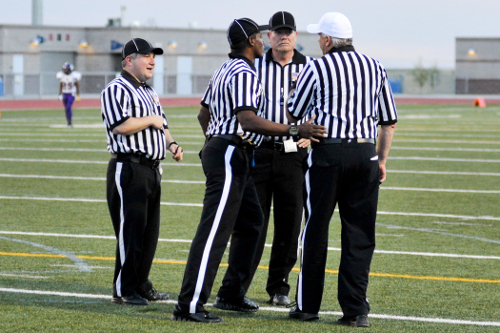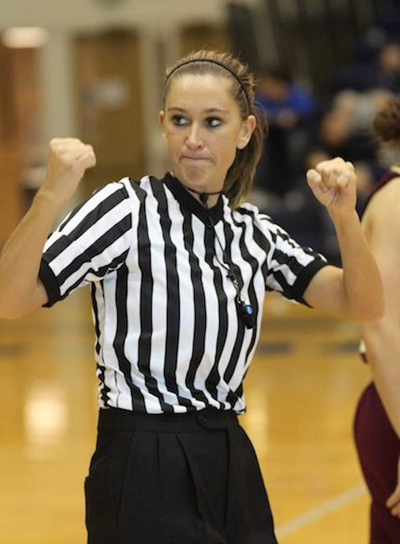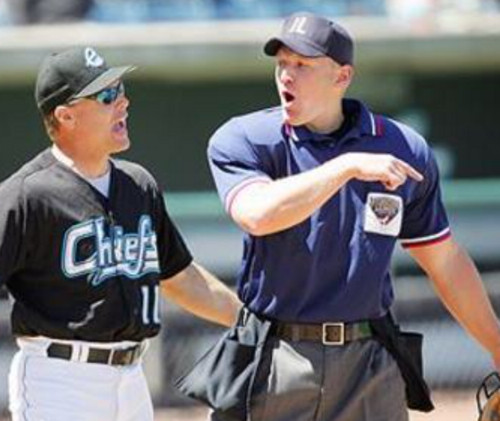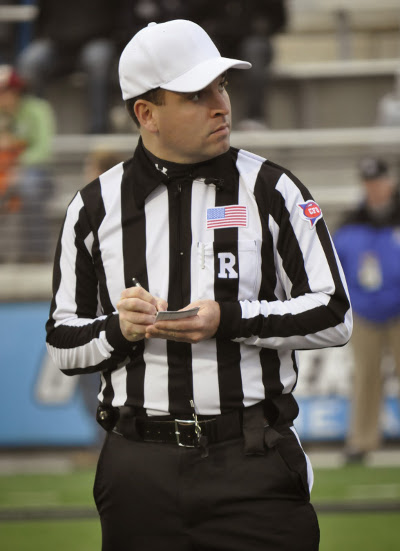Video Review Offers Officials a New Way to See the Game
By Rob Kaminski on February 19, 2015 officials Print
The words, “after further review,” are now common sports vernacular, serving as proof that video review is a big component of sports at the highest levels.
Ironically, the oft-maligned officials who deliver the subsequent verdicts very often log more video hours than watching the player who did not stay in bounds, or shot the ball before the buzzer.
Game officials are passionate students of the games they officiate, and video sessions have become vital to preparation and advancement. As with coaches and athletes, accessibility to such resources has never been more plentiful for officials at all levels.
The boom has occurred at such a meteoric rate that it’s difficult to imagine life without video.
“When I was just beginning, it was pretty rare to have video of yourself,” said Meghan Joseph, a Capital Area (Michigan) Officials Association member who now works NCAA basketball. “Before online video, you’d have to watch games on TV and emulate what those officials would do and incorporate it into your game.”

Meghan Joseph
Joseph just turned 30 and was the youngest NCAA Division 1 Women’s Basketball official when she received her first assignment at that level eight years ago. Eight years in the technological realm can seem like a lifetime.
Today’s newer contest officials are among the most ardent beneficiaries of hi-tech devices and continual change. It’s what they grew up with. Now, they have the ability to apply all of it to an avocation they love.
And, in today’s world, that application not only comes before and after contests, but often times during contests. Video has changed the way the game is called at higher levels of sports, but it’s also making its way to the high school level on a limited basis.
In 2010, the Michigan High School Athletic Association (MHSAA) adopted the use of video on a limited basis. For both genders of the MHSAA Basketball Semifinals and Finals, officials may use the courtside monitor to determine whether an attempt is good or no good, or whether it is a two-point goal or three-point goal, only when the clock reads 0:00 at the end of a game.
Ice hockey began to employ a similar system in 2011 for its semifinals and finals, only reviewing whether a puck crosses the line and/or beats the clock.
“I was involved in putting a bug in the ear regarding the use of video for our Finals,” said veteran ice hockey official Jim Garofalo of Howell. “Why not use it if it’s there? And, only when the goal line is involved. Simply, is it a goal or not a goal? Did the puck go in or didn’t it? That’s all we need. From that standpoint, technology is a great tool. We all want the right results.”
Video consultation is also permitted at the MHSAA Cross Country and Track and Field Finals for situations at the finish line if there is a challenge, an error in the finish placement or malfunction of the timing system.
As most MHSAA Finals are now either televised or streamed online, video is readily available, making such use a possibility. However, there is no intent to bog down school sports contests with an abundance of replay, for a number of reasons. Foremost is the fact that the presence of adequate video equipment is lacking at all levels for all games. The MHSAA has adopted use only in extreme circumstances at the highest level, where solid video evidence may exist.
The expectations placed on high school officials, however, are often the same as those placed on arbiters at the collegiate and professional levels.
“The biggest change in the games today – basketball, football, baseball, etc. – is technology,” said West Bloomfield’s Lamont Simpson, a MHSAA registered official who also has worked numerous WNBA Finals and NCAA Men’s Basketball Tournaments. “And with technology comes increased expectations. It used to be that people could accept an occasional missed call. Now, they want you to get them all right. The level of scrutiny has greatly increased because there are cameras everywhere. It changes the way you call a game.”
In an avocation that calls for confidence, knowledge, patience, and physical and mental stamina, humility can be overshadowed by ego. That’s why it’s important to keep the big picture in mind while looking at the smaller pictures on today’s many devices, says David Uyl, who worked four seasons at the Triple A baseball level and two MLB Spring Training seasons in Arizona during his professional days.

David Uyl
“The important thing to remember is that you’re one crew. At the end of the day, the objective is to get it right. You can’t have hurt feelings about having a call overturned, and you can’t be afraid to look at a replay and overturn it. It isn’t called ‘show friends,’ it’s called ‘show business.’ This is a business,” said Uyl.
Video has moved from training sessions to the rules books, with MLB becoming the last major sport to incorporate replay provisions.
Joseph, meanwhile, already has experience with monitor reviews at the collegiate basketball level.
“We have rules in place for certain situations throughout the contest where we are required to go to the monitors,” Joseph said. “There is certainly less room for interpretation or judgment, but on the other hand, there is a whole new set of rules dealing with monitor review. From a fans perspective, many think we go to the monitor when we feel like it, when really there are certain situations that we have to go to the monitor. That gets magnified in the last minute of a close contest, which is often the only part that fans remember.”
Cameras can also have an effect on games even before plays get to the review stage. The human element of officiating still remains, but it in different ways.
“In Triple A ball and the Arizona Fall League, we had QuesTec (used by Major League Baseball for the in early 2000s for purpose of providing feedback and evaluation of Major League umpires), and after every game you’d leave with a disc and a score on it,” Uyl said. “Video doesn’t lie. It’s an evaluation tool, and it’s here to stay. You kind of start officiating to the video; certainly we see that in football with the replay at the collegiate and professional levels.”
And, as the in-game usage continues to trickle down, an increasing number of officials are being asked to call to the cameras. Jeremy Valentine is a college football official, who has worked in Division I FCS in the Pioneer League, and Division II, where he worked the 2013 National Championship game. The targeting penalty was implemented for NCAA Division I play last year and now has reviewable components in place for Divisions II and III.
How can such techniques be implemented at the prep level? Valentine believes that with new targeting rules now in place for high school football, perhaps a halftime review similar to Division II and III collegiate levels could be helpful in determining if an innocent player could be returned to action.

Jeremy Valentine
“I can see a similar place in high school sports for these types of scenarios,” said Valentine. “It would also be helpful to allow the officials to use video following the contest to determine which players may have been involved in flagrant acts during the game, or to also reinstate players that may have been incorrectly ejected (for example, No. 12 was ejected for fighting when No. 15 was actually the player involved).”
In the officiating industry, video has evolved into a three-headed monster of technology: it can hover like a noose, act as a crutch, or serve as the fuel that drives officials training. The key is to tame the beast and make it work for all involved. When it’s at its best, it rights the occasional wrongs and improves the games which serve so many.
Rob Kaminski
Rob Kaminski is the website and publications coordinator for the Michigan High School Athletic Association and is a member of the NFHS Officials Publications Committee.
Most Recent Articles
- nfhs news NFHS Learning Center Delivers 25 Millionth Course
- Track & Field/Cross Country article Effective Communication with Athletes and Coaches
- nfhs news Player Equipment Changes Highlight 2025 High School Football Rules Revisions
- Player Equipment Changes Highlight 2025 High School Football Rules Revisions
- nfhs news Judgment Call on Second Contact Eliminated in High School Volleyball






